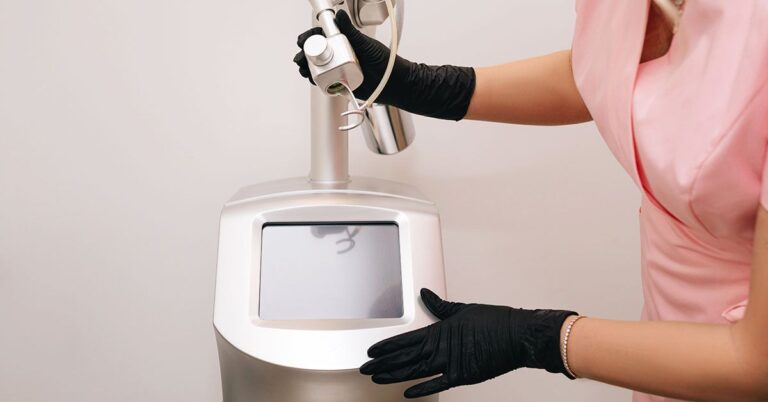CO2 Laser treatment for hidradenitis suppurativa (HS) shows promise for reducing inflammation, draining abscesses, and improving scarring.
HS is a chronic skin condition characterized by painful, recurring nodules and abscesses, often in areas with sweat glands, such as the armpits and groin. The condition significantly affects the quality of life and is difficult to treat.
In recent years, laser treatments have become increasingly popular for the management of HS. One such treatment is carbon dioxide (CO2) laser therapy, which is a minimally invasive surgery that vaporizes the affected tissue. This approach may benefit HS by reducing inflammation, draining abscesses, and promoting healing.
CO2 Laser treatment involves the use of a high-energy laser beam aimed precisely at the affected areas of your skin. The laser energy is absorbed by the water in your skin cells, causing the cells to evaporate. This procedure removes diseased tissue, including hair follicles and sweat glands, which are often affected in HS.
The laser also stimulates the production of collagen, which is a key component of healthy skin. This promotes the healing process and can improve the overall appearance and function of the skin in the treated areas.
CO2 Lasers can be used to treat HS. By removing the affected tissue, CO2 The laser helps reduce the inflammation, pain and drainage associated with HS.
A 2015 study evaluated the effectiveness of CO2 laser ablation for the treatment of HS lesions in 58 participants over a mean follow-up period of 25.7 months.
The results showed that 95% of participants reported some or great improvement and 91% would recommend surgery. However, 29% relapsed within the treated areas after 12 months, with obesity identified as a risk factor.
In one study of eight subjects with moderate to severe HS, researchers found that using a mixed-techn. CO2 and the Ga-As (gallium arsenide) laser have had positive effects, including reduction of active lesions, inflammation, tenderness, and flares.
Some participants experienced complete resolution of the treated lesions, although new lesions appeared in some cases, requiring continued treatment. Laser treatment was well tolerated, with temporary redness and a slight burning sensation being the most common side effects. No hyperpigmentation or scarring was observed.
CO2 Laser treatment for HS offers many benefits:
- Targeted therapy: CO2 Laser treatment specifically targets the affected tissue, minimizing damage to the surrounding healthy tissue.
- Promotes healing: The laser energy promotes the formation of healthy tissue and stimulates collagen production. This helps in the healing process and improves the overall appearance of your skin.
- Improves Scars: Research suggests that CO2 Laser therapy may be a promising option for improving the physical appearance of scars in people with HS.
- Minimally invasive: CO2 Laser treatment is less invasive than traditional surgery, resulting in faster recovery.
- Long-lasting results: CO2 Laser therapy can provide long-lasting results for people with HS, reducing the need for frequent treatments.
CO2 Laser treatment for HS, like any medical procedure, carries some
- Pain: Some people may experience pain or discomfort after the procedure, which can usually be managed with pain medication.
- Swelling and redness: Swelling and redness at the treatment site are common and usually go away on their own within a few days.
- Scars: While CO2 Laser treatment can improve the appearance of scars, there is a risk of new scars or worsening of existing ones.
- Contamination: There is little risk of infection after CO2 laser treatment, which can usually be treated with antibiotics.
- Changes in skin pigmentation: CO2 Laser treatment can sometimes cause changes in skin pigmentation, such as lightening or darkening of the skin.
- Burns: In rare cases, the laser can burn your skin, which can lead to scarring or other complications.
Who should not use CO2 laser treatment?
The following individuals may not be eligible for CO2 laser treatment:
- Pregnant women: Safety during pregnancy
is not established . - People with an active skin infection: The CO2 The laser can potentially spread the infection to surrounding areas.
- People with a history of keloid scars: Keloid scars tend to recur and worsen with skin trauma, including laser treatments.
- People with certain medical conditions: CO2 Laser treatment may not be suitable for people with skin cancer or autoimmune disorders.
- People taking medications that increase scarring or interfere with wound healing: These drugs may include corticosteroids or immunosuppressants or chemotherapy drugs.
The cost of CO2 Laser treatment for HS can vary widely depending on several factors, including the extent of the treatment area, the severity of the condition, the number of sessions required, and the geographic location of the treatment facility.
Generally, a CO2 laser therapy session costs $3,400 on average, with total treatment costs ranging from a few thousand to tens of thousands of dollars.
Insurance will cover it CO2 laser hair removal for HS?
CO2 Laser treatment for cosmetic purposes is often not covered by health insurance. Insurance companies are more likely to cover CO2 laser treatment for HS if deemed medically necessary to treat the condition.
This may include cases where other treatments have failed or where the condition causes significant pain, discomfort or functional impairment.
However, it is important to check with your insurance provider to determine if the treatment is covered by your plan.
CO2 Laser therapy for HS involves the use of high-energy lasers to remove the affected tissue and promote healing. It can improve HS by reducing the inflammation, pain and drainage associated with the condition. The laser also stimulates collagen production, helping the skin heal and improve its appearance.
If you are thinking of CO2 laser treatment for HS, consult a healthcare professional to determine if it is the right option for you.


